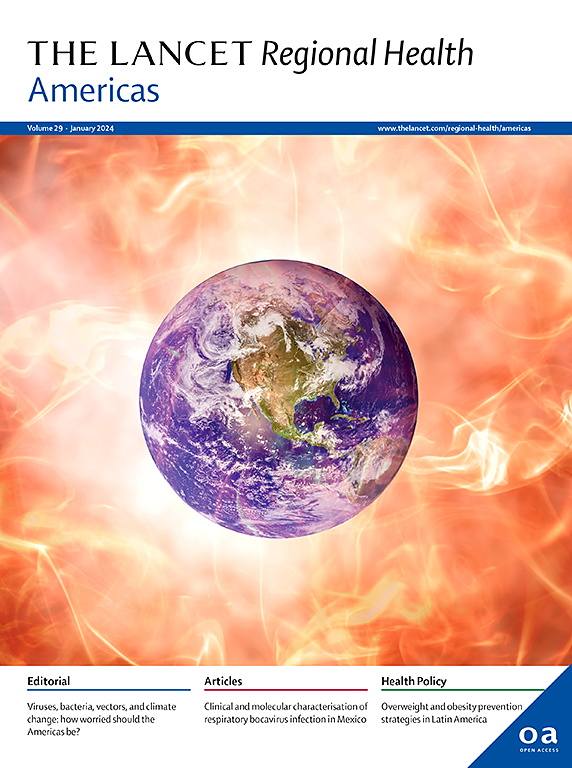墨西哥HPV患病率、细胞学异常和HPV疫苗的影响:一项对596,944名妇女的全国性研究
IF 7
Q1 HEALTH CARE SCIENCES & SERVICES
引用次数: 0
摘要
宫颈癌(CC)仍然是世界范围内一个重大的公共卫生挑战,是墨西哥妇女癌症相关死亡的第二大原因。虽然CC是高度可预防的,但有效实施筛查计划以发现患有癌前病变的妇女对于减轻其负担至关重要。本研究评估了来自墨西哥所有32个州的596944名妇女的HPV感染、其与细胞学异常的相关性以及HPV疫苗接种的影响。方法使用全自动分子生物学实验室设备(罗氏Cobas prime - Cobas 6800)对样品进行处理,细胞技术人员评估细胞学结果。发现25岁以下女性中HPV感染率最高,有23,615人(37.4%)检测呈阳性。这主要是由于检测中合并的高危HPV基因型感染(HPV31、33、35、39、45、51、52、56、58、59、66和68),共22,792例(36.1%)。HPV16和HPV18在25-34岁女性中最为流行,分别有7251例(5.21%)和3281例(2.36%)感染。低级别鳞状上皮内病变(LSIL)是最常检测到的细胞学异常,在15411例(2.6%)中发现,主要与合并HPV基因型相关(73.7%)。两剂HPV疫苗接种方案对HPV16(优势比[OR] = 0.21)和HPV18 (OR = 0.33)具有很强的保护作用,但没有显著降低合并HPV基因型感染的患病率(OR = 0.98)。HPV POOL的显著致癌潜力强调了需要更广泛的疫苗配方。在未来的运动中采用无价疫苗、扩大筛查覆盖率和加强对年轻妇女的性教育是帮助决策者减轻墨西哥CC影响的关键措施。这项工作由Salud Digna资助。本文章由计算机程序翻译,如有差异,请以英文原文为准。
Prevalence of HPV, cytological abnormalities, and impact of the HPV vaccine in Mexico: a Nationwide Study of 596,944 women
Background
Cervical cancer (CC) remains a significant public health challenge worldwide and is the second leading cause of cancer-related death in women in Mexico. Although CC is highly preventable, effective implementation of screening programs to detect women with precancerous lesions is crucial to reduce its burden. This study evaluated HPV infection, its correlation with cytological abnormalities, and the impact of HPV vaccination in 596,944 women from all 32 states of Mexico.
Methods
Samples were processed using a fully automated molecular biology laboratory setup (Roche Cobas prime - Cobas 6800), and cytotechnologists assessed cytological outcomes.
Findings
The highest prevalence of HPV infection was observed among women under the age of 25, with 23,615 individuals (37.4%) testing positive. This was primarily attributable to infections with the pooled high-risk HPV genotypes included in the assay (HPV31, 33, 35, 39, 45, 51, 52, 56, 58, 59, 66, and 68), which accounted for 22,792 cases (36.1%). In contrast, HPV16 and HPV18 were most prevalent among women aged 25–34 years, with 7251 (5.21%) and 3281 (2.36%) infections, respectively. Low-grade squamous intraepithelial lesion (LSIL) was the most frequently detected cytological abnormality, identified in 15,411 cases (2.6%), and was predominantly associated with the pooled HPV genotypes (73.7%). A two-dose HPV vaccination regimen conferred strong protection against HPV16 (odds ratio [OR] = 0.21) and HPV18 (OR = 0.33), but did not significantly reduce the prevalence of infection with the pooled HPV genotypes (OR = 0.98).
Interpretation
The notable carcinogenic potential of the HPV POOL underscores the need for broader vaccine formulations. Adopting a nonavalent vaccine in future campaigns, expanding screening coverage, and reinforcing sexual education for younger women are key measures to help policymakers mitigate the impact of CC in Mexico.
Funding
This work was funded by Salud Digna.
求助全文
通过发布文献求助,成功后即可免费获取论文全文。
去求助
来源期刊

Lancet Regional Health-Americas
Multiple-
CiteScore
8.00
自引率
0.00%
发文量
0
期刊介绍:
The Lancet Regional Health – Americas, an open-access journal, contributes to The Lancet's global initiative by focusing on health-care quality and access in the Americas. It aims to advance clinical practice and health policy in the region, promoting better health outcomes. The journal publishes high-quality original research advocating change or shedding light on clinical practice and health policy. It welcomes submissions on various regional health topics, including infectious diseases, non-communicable diseases, child and adolescent health, maternal and reproductive health, emergency care, health policy, and health equity.
 求助内容:
求助内容: 应助结果提醒方式:
应助结果提醒方式:


